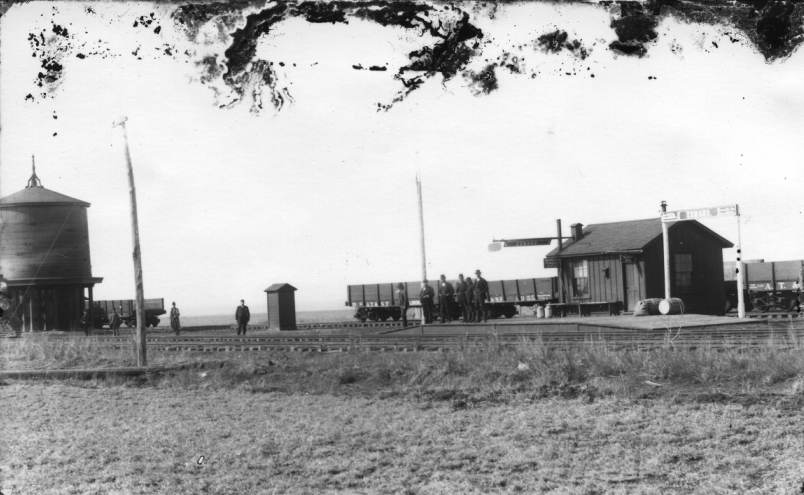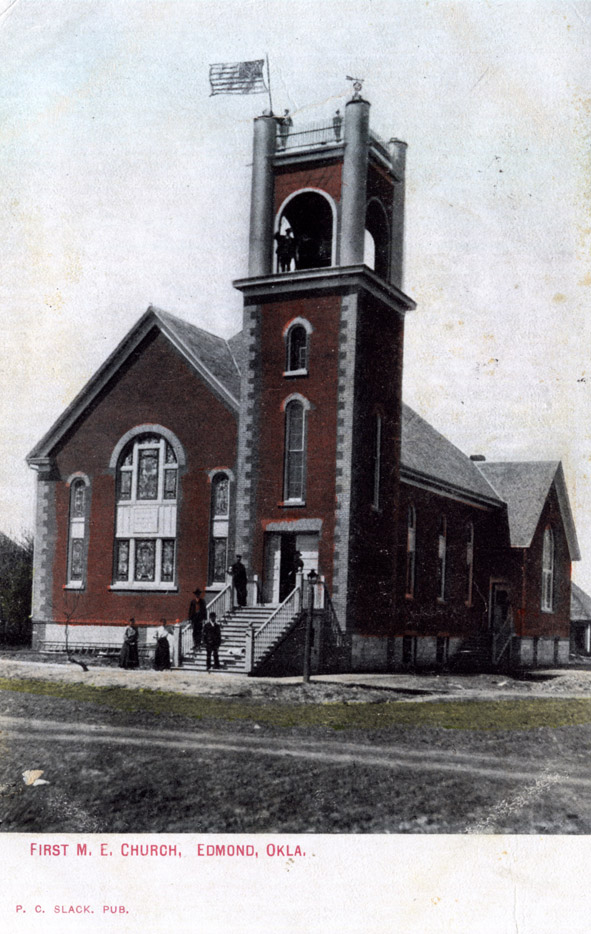
EDMOND.
Edmond’s beginnings are attributed to the Atchison, Topeka and Santa Fe Railway, which built its line south through the Unassigned Lands in the 1880s. Located at a point originally called Mile Marker 103, Edmond was a coal and watering stop on the Atchison, Topeka and Santa Fe Railway line. Later the stop was called Summit because it was thought to be the highest point between the Cimarron and Canadian rivers. On March 28, 1887, the Santa Fe officially named the station Edmond in honor of Edmond Burdick, a Santa Fe traveling freight agent. Edmond Station was first operated by John Steen, with support from his wife Cordelia and their son Charley. Edmond is located in northern Oklahoma County, approximately fifteen miles north of downtown Oklahoma City. As with many other communities throughout the area, Edmond got its start as a town on April 22, 1889, with the opening of the Unassigned Lands. Edmond is home to many firsts in Oklahoma Territory, including the first church building, St. John the Baptist Catholic Church, dedicated June 24, 1889; the first continuous newspaper, the Edmond Sun, founded by Milton “Kickingbird” Reynolds on July 18, 1889; and the first public schoolhouse, completed in August 1889. On March 28, 1887, the Santa Fe officially named the station “Edmond” for an employee, Edmond Schuyler Burdick. A twenty-nine-year-old Wisconsin native and University of Wisconsin Law School graduate, he was an assistant right-of-way agent while the railroad was designating the station points south from Kansas.
Education forms a significant part of Edmond’s history. An important local institution is the University of Central Oklahoma. Originally named the Territorial Normal School in 1891, it prepared students to become teachers. Although it has changed names several times and expanded its curriculum, becoming the University of Central Oklahoma, its first building, Old North Tower, still remains the campus focal point. College classes were held in Old North Tower beginning in January 1893. The University of Central Oklahoma offers a positive economic impact by being one of the community’s largest employers. The city also supports an extensive public school system that includes three large high schools.
Edmond’s economic base, growing from the railroad, the normal school, and a surrounding agricultural area, expanded with the discovery of oil in the West Edmond Field during the 1930s and 1940s. Transportation access, always important to the growth of a town, included the arrival of the railroad in 1887 and an interurban line in 1911, designation on U.S. Highway 66 (Route 66) and Highway 77 in the late 1920s, and proximity to Interstate 35 from the early 1960s. More convenient approaches and roads into Edmond in the 1950s and 1960s brought population growth and a corresponding increase in the infrastructure, more schools and businesses in the 1970s and 1980s, numerous housing additions, and active citizen participation in the 1990s through the millennium. Edmond Electric, a municipally owned system and one of only thirty-five in the state, has provided power since 1908.
Two important moments highlight Edmond’s recent history. In 1986 an Edmond postal employee shot and killed fourteen of his co-workers at the post office. On a more positive historical note, Edmondite Shannon Miller participated in the 1992 and 1996 Olympics. She became the most decorated gymnast in United States history.
The city’s residents support numerous cultural institutions. They include the Fine Arts Institute of Edmond and the Edmond Historical Society Museum, located in a 1936 National Guard Armory that is listed in the National Register of Historic Places (NR 91000275). Among other listed properties are the American Legion Hut (NR 93001336) and Old North Tower (on UCO campus, NR 71000671). The city’s numerous public recreation areas include eighteen parks, several golf courses, one of Oklahoma’s first skate parks, championship-quality soccer fields, an aquatic center, and a tennis center. Nearby Lake Arcadia provides boating and fishing opportunities and each January hosts an Eagle Watch. Edmond Liberty Fest, a week-long Fourth of July celebration, annually attracts 125,000 visitors. An Art in Public Places program, established in 2001, has placed dozens of sculptures throughout the community in parks and along streets. The city also hosts an annual Downtown Arts Festival. A farmers’ market, located downtown in Festival Market Place, provides a venue for sale and purchase of locally grown produce during the summer.
Edmond has grown into a large city but maintains its heritage and small hometown characteristics. On April 22, 1889, the town had a population of 150 citizens, mostly men. The census reported 1,534 in 1900 and 3,576 in 1930. After World War II the number reached 6,068 in 1950, 8,577 in 1960, and 16,633 in 1970. The suburban community grew rapidly to 34,637 in 1980, 52,315 in 1990, 70,994 in 2000, and 81,405 in 2010. Newspapers have included the Edmond Enterprise, the Edmond Booster, the Edmond Sun, and more recently, Edmond Life and Leisure. The City of Edmond maintains a council-manager form of government. The citizens elect a mayor and four city council members. These in turn appoint a city manager. In 2001 citizens elected Edmond’s first woman mayor, Saundra Gragg Naifeh. In 2021 Darrell Davis was elected Edmond’s first African American mayor. In April 2020 the census reported 94,436 residents.
See Also
EDMOND POST OFFICE MASSACRE, LAND RUN OF 1889, SETTLEMENT PATTERNS, UNIVERSITY OF CENTRAL OKLAHOMA








